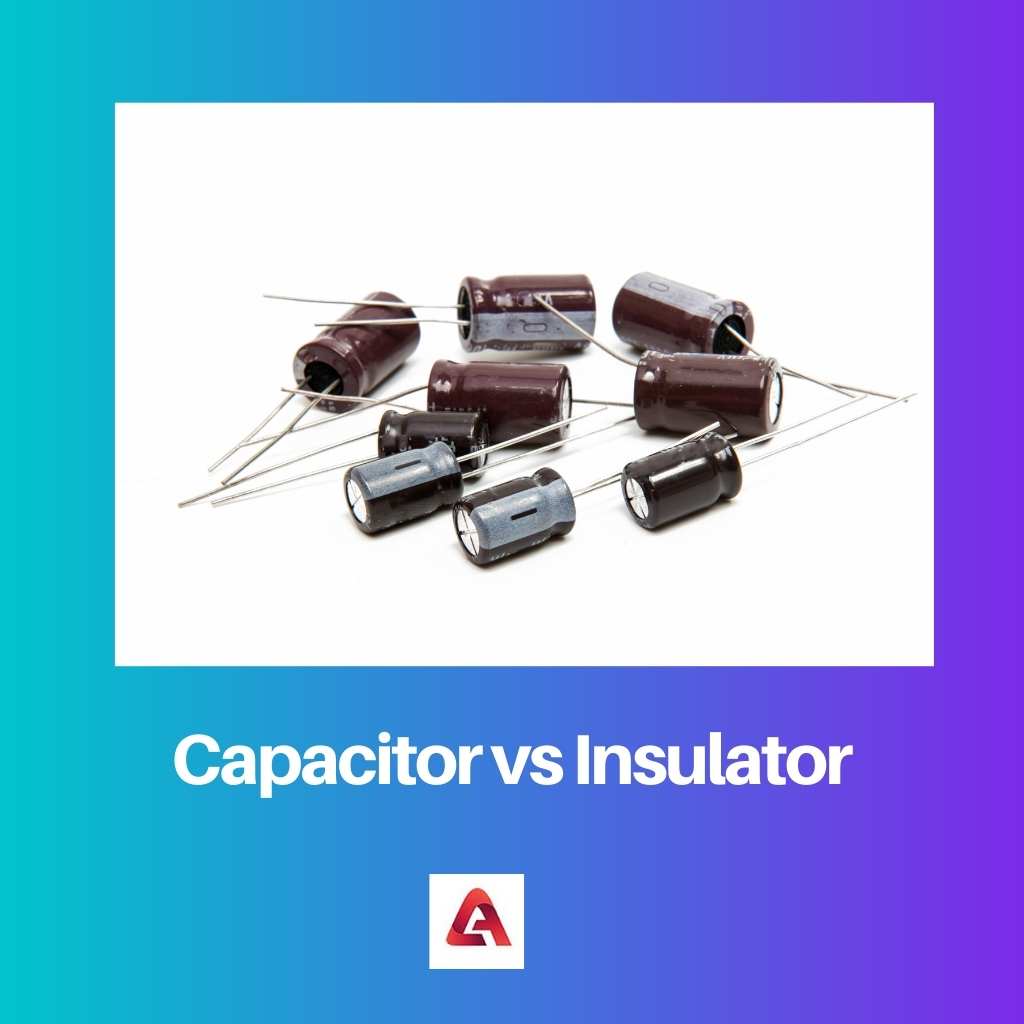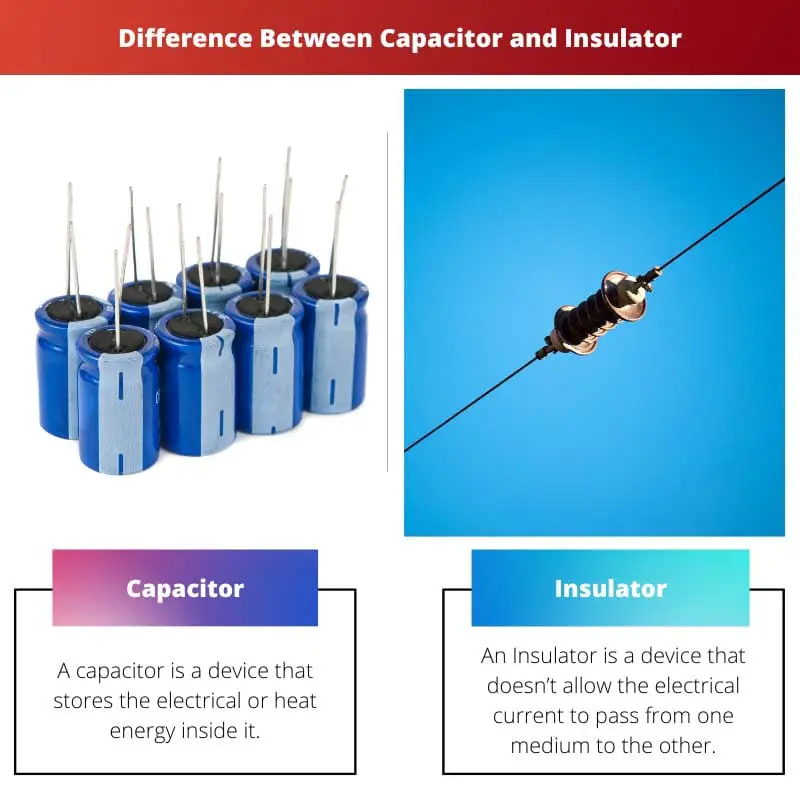In simple terms, a Capacitor is a device whose function is to store the heat energy inside it and deliver the energy when required.
An Insulator is the one whose function is to stop the heat transfer from one device to another, i.e., it doesn’t allow the heat to get transferred. Capacitors are widely used in the digital board circuits and semiconductor industry.
Key Takeaways
- A capacitor is a component that stores electrical energy, while an insulator is a material that does not conduct electricity.
- Capacitors are used in electrical circuits to regulate current flow, while insulators are used to prevent current flow.
- Capacitors store electrical energy in an electric field, while insulators block the flow of electrons.
Capacitor vs Insulator
The difference between Capacitor and Insulator is that Capacitor stores the heat energy inside it. On the other hand, the Insulator is a device that doesn’t allow the heat to be transferred easily. Both these devices are mainly used in the semiconductor field. A Capacitor varies in size depending on the amount of energy to be stored.

A Capacitor, in simple terms, is a device that stores the potential energy inside. There are two plates, one having the positive charge and the other having the negative charge.
The Total charge is defined in terms of +Q and -Q. They are mainly used in digital circuits like motherboards, Television, etc.
Insulators are materials whose main purpose is to stop the transfer of heat energy or electrical energy from one medium to the other.
This means if the insulator is used, it will stop the flow of electrical energy. Insulators are made up of plastics, rubber, glass, and other materials which do not allow the current to pass from one medium to another.
Comparison Table
| Parameters of Comparison | Capacitor | Insulator |
|---|---|---|
| Definition | A capacitor is a device that stores the electrical or heat energy inside it. | An Insulator is a device that doesn’t allow the electrical current to pass from one medium to the other. |
| Size | Capacitors can range from small to big sizes depending on the energy to be stored. | Insulators are mostly big. |
| Charges | It stores the charges and it is referred to as the Capacitor charge with the symbol +Q/-Q. | It forbids the charges. |
| Bonds | Weak bonds compared to the Insulator. | It has high covalent bonding which forbids the flow of current from one to another. |
| Application | It is widely used in circuit boards and power cables. | It is used in conducting wires and voltage systems. |
What is Capacitor?
A Capacitor is a device that stores the electrical energy inside it and releases this electrical energy when it is being required by the system.
When the energy is stored inside, it gets heated as the charge +Q is being stored in it, and when the energy is being released, the charge +Q gets converted into -Q.
Inside the Capacitor, there are two plates that act as a medium to store the two energy which are called positive energy and negative energy.
The positive energy is referred to as +Q charge, while the negative energy is referred to s the -Q charge.
The important fact is that these two plates are separated by an Insulator medium in between them. The function of this Insulator is to stop the transfer of energy from one plate to another.
The Capacitors are mainly used in digital boards like motherboards or PLC circuit boards. If you have noticed the digital boards, there are small cylindrical pieces attached to the board, which is nothing but the capacitors only.
Once the system runs, it starts storing the energy inside it. If you ever touch the top of the capacitor, you will feel the heat. This heat is produced as the energy is being stored in it.
Capacitors can come in various sizes depending on the energy stored. For example, ever noticed when installing the ceiling fan, there is a white colored cylindrical piece. It’s a Capacitor of a big size.

What is Insulator?
An Insulator is a device whose main function is to forbid the flow of current from one medium to the other, i.e., It doesn’t allow the electrical energy to be transferred from one to another.
The only possible way to forbid the flow of current from one to another is by using a material that doesn’t allow the flow of current, like plastics, rubber which is known as an excellent Insulator material.
These all materials are used to make the Insulator.
They mainly work as the protectors in the electrical system. There are many other forms of insulators like Thermal Insulators, Sound Insulators, etc. The only aim is that it stops the heat or sound from travelling from one to another.
Thermal Insulators are used in clothing materials like Insulator tents. These tents are used in extremely cold weather conditions where there is no source of heat when the person is living inside them.
The body releases some form of heat, and that heat gets stored in the tent and doesn’t allow it to pass outside, which makes the temperature different compared to the outside.
Insulators have a strong covalent bond formation which ultimately obstructs the flow of energy from one medium to another.

Main Differences Between Capacitor and Insulator
- The Capacitor is a device whose function is to store the energy and release it when it cannot go outside, i.e., It doesn’t allow the energy to get transferred to another medium.
- The size of the Capacitor can be small and big depending on the energy to be stored, whereas the size of Insulators is big like the one it is used in the High Voltage transmission at the end of the wire.
- Capacitors are mostly costly as compared to the Insulators that are cheap as they are made up of simple materials like plastic, rubber, and glass, which makes them cheap.
- Capacitors have weak bonds, which allow them to transfer the heat, while the Insulators have strong covalent bonds, which makes the energy impossible to get transferred with other mediums.
- The die-electric(k) constant is higher for the Capacitors when compared to the Insulators, which have a lower die-electric constant(k)

- https://www.nature.com/articles/nnano.2009.37
- https://ieeexplore.ieee.org/abstract/document/919238/?casa_token=Sb_Jit11ZPcAAAAA:E_xcL6HFRgR-q_JvtDxHfa8lSTh0uGymQXChuLc_09Y_wSHf5fpfG3uRc6aD3rGOq84G8k2D
